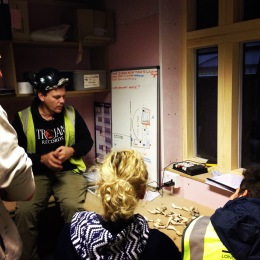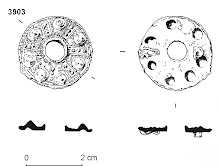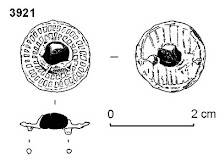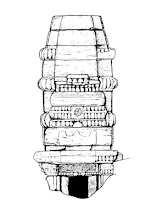My work as an archaeologist has often involved both receiving
and giving on-site training, from a brief chat about how to record a context
to a structured training session on stratigraphy or Roman building
techniques. Training and development is central to every archaeologist; every
project is different and there is always something new to learn, and that is
one of the things that makes archaeology such a fulfilling and fascinating
discipline. Training provision and Continuing Professional Development,
although core to the profession, has been neglected and can often be reduced to
Health and Safety courses such as First Aid at Work or CAT and Gennie, rather
than specific, ongoing training in carrying out the day-to-day role. Over the
last few years I've been working on how to change this, to make training
available to all staff, at the place of work, and throughout their careers.
 |
| Training site staff: clay tobacco pipes. photo LP Archaeology |
Whilst working at MOLA about ten years ago I independently started
developing training materials for site staff -simple one or two page handouts
for use in archaeological 'toolbox talks' given to the whole site team, or as
the foundation for more focused one-to-one mentoring and training. The
materials were made available as free downloads, and later led to work
providing training materials and sessions for archaeological companies. My
interest in training combined with an involvement in Diggers' Forum (a
campaigning group within the Chartered Institute for Archaeologists) and led to
research into how we provide, and document, training and CPD for the many, not just
the few; something that paralleled and echoed work by several others including
the now hugely successful BAJR Skills Passport.
Looking into how archaeologists are trained, it was clear
that there were real problems with training provision at all levels, and that these
problems had been known for some time; however there had been little work on
how to change this situation. At one level there seemed to be a mutual blame game
between universities and employers as to who should train new entrants (for
example see papers given to the 2012 FAME Forum). Although some university
departments, such as Winchester, offer a solution to this conundrum by providing
courses designed for those intending a career in professional archaeology.
Several industry schemes offered possible routes out of the
training impasse, but nearly all were focussed on the individual, not the team:
the IfA developed a series of Workplace Learning Bursaries with its partners, but these largely
addressed the needs of a few fortunate individuals, rather than the majority of
staff. The bursaries did reportedly change the way the host organisations thought about
training, but there is little evidence that they improved training for their
rest of staff, and certainly there was no flood of companies stepping forward
to fund their own bursaries. The NVQ in Archaeological Practice is another scheme that has so
far failed to achieve its potential, although the related development of the
National Occupational Standards for archaeology has created a useful framework
for archaeological training schemes, especially when seeking to tap into funding
sources for apprenticeship schemes from the Department of Business Innovation
and Skills. These apprentice schemes have great potential in providing individuals
with new ways into the profession, with funded, structured, on-the-job training
and the development of apprenticeships has the possibility of helping train
existing staff through the development of training materials and techniques.
Individual employers have also developed schemes; Cotswold
Archaeology developed a set of 'Designate' schemes, for Supervisors, Project Officers
and Project Managers, training and supporting existing staff into new roles.
Whilst I worked at Cotswold Archaeology I developed a series of training
sessions and materials that were given to all staff, not just designates, part
of a commitment to training that went beyond the individual.
More recently I worked with LP Archaeology on their year-long
100 Minories site; there we provided training on a two-prong approach: LP ran a
series of pub-based 'Symposium' sessions with speakers on a wide range of
topics related to the site, whilst I embedded training into the working day,
with inter-active site tours, talks from visiting specialists, discussions on specific
artefacts and buildings, as well as more structured training sessions on aspects
of site-work ranging from matrices, photography and paperwork checking through
to clay pipes and bricks.
My research and practice has led to a firm belief that training should be available for all staff, not just the fortunate or pointy-elbowed, that training should be available at the place of work, linked to the work wherever possible, and that training is a mutual commitment that requires work from employer and employee. I developed the idea of a Training Hour, intended to deliver this training on site, at minimal expense or time cost, and to change the training culture into a positive one rather than a tick-box CPD scheme.
The Training Hour is intended to be a mutual commitment to
provide/receive roughly an hour a week of work-related training. This can be
provided by site colleagues or visiting specialists, by an interactive site
tour, by one-to one mentoring or training, or Toolbox Talks. Short, bite-sized
chunks of training that can be related to both the site and the team. Once
training is embedded into the working week it can finally become a mutually valued and fundamental part of the
job, and stop being seen as a chore or irrelevant, but as a way of becoming a better
archaeologist.
For more on the Training Hour concept see Training Diggers and Changing Cultures: Embedding a ‘Training Hour’ within the Working Week, published in The Historic Environment, Vol. 6 No. 2, September 2015, 167–76














